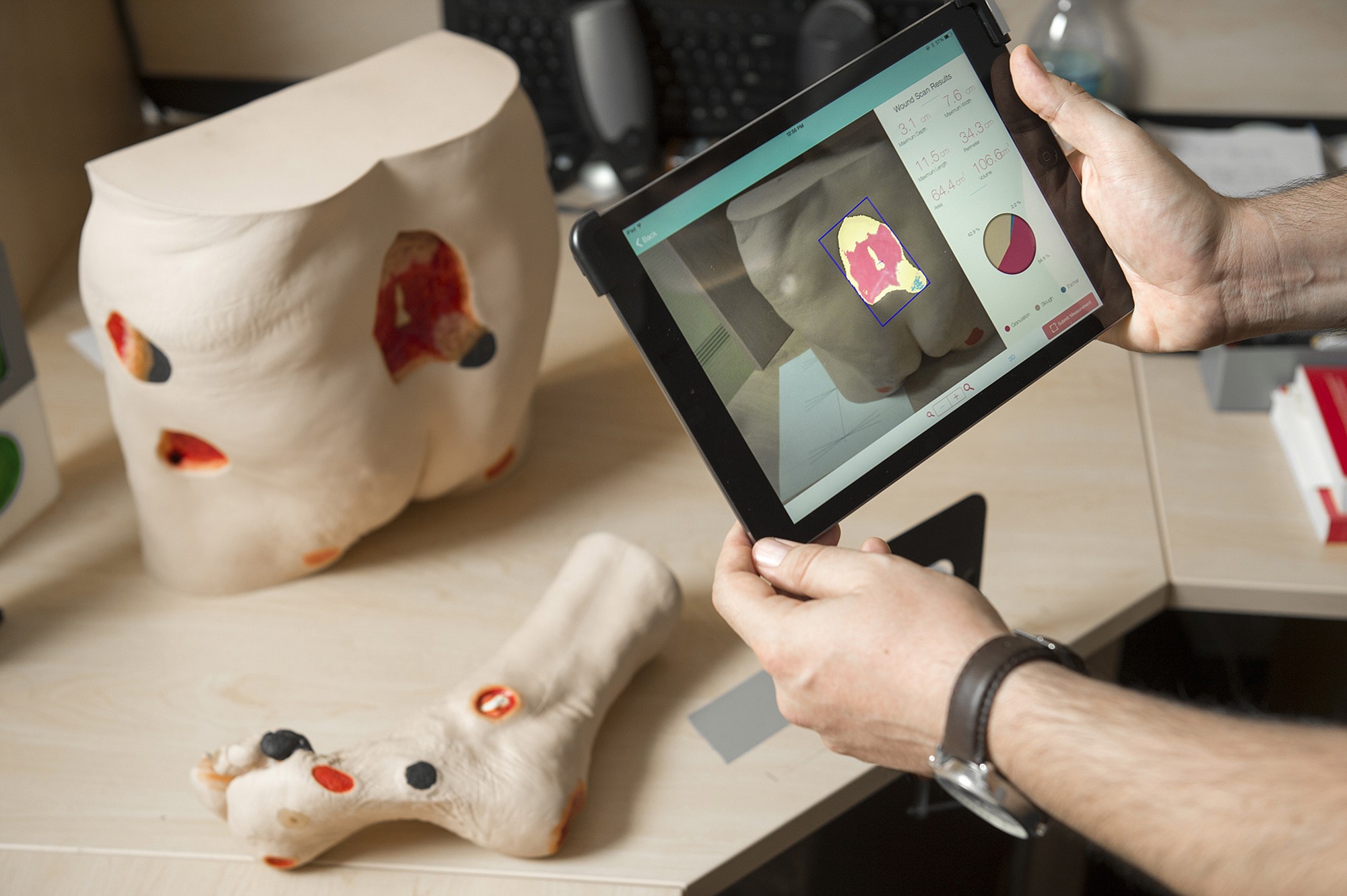The digital age has finally reached two of the oldest medical problems: bedsores and skin ulcers, which can be incredibly painful and take forever to heal. Doctors often track the progression of these wounds over months, sometimes years, switching up treatments if they don’t see improvements.
The tools used for such tracking are decidedly old-fashioned: a plastic ruler or measuring tape to see if the wound has gotten smaller, a plunging cotton swab into the sensitive lesion to check its depth and a simple look to spot any new tissue growth. Such imprecise methods skimp on accuracy and can cause more pain to the patient.
Now an effort is underway to advance wound care by replacing rulers and swabs with smartphones and iPads. Two startups have created systems that allow caregivers to take photos using an app downloaded to mobile devices. These photos are then analyzed to determine the dimensions of the wound and how much of the affected tissue is dead and how much is healing.
“In the area of wounds, things are kind of still in the Dark Ages,” said plastic surgeon Daniel Ceradini at NYU Langone Medical Center, who is not involved in either company. “Some medical centers do use a digitally based system, but the vast majority of practices are still using physical rulers.”
A big problem with rulers and swabs is the inaccuracy and human error involved. For instance, nurses are often asked to record the maximum length and width of the wound — not an easy task when wounds come in all sorts of amorphous shapes and sizes. The size of the wound is then estimated by multiplying this length and width, a method that one study found overestimates by an average of about 40 percent.
Also, numbers can differ a great deal depending on the person who is doing the measuring. All these factors can lead to false information about how a wound is healing — which can cause a doctor to give up on a treatment that is working or stick with a treatment that isn’t.
“In a nutshell, we’re taking the guesswork out of wound care,” said Kevin Keenahan, the co-founder of one of the startups, Baltimore-based Tissue Analytics.
With its app, a clinician takes photos of the wound using a smartphone. Each picture is corrected for such attributes as brightness and shot angle; then the app’s algorithm calculates wound dimensions, perimeter and how much the wound has shrunken since the last measurement. It also tracks the percentage of tissue that is healing and the percentage that is dead.
The app also links to a site that allows doctors to access the photos and wound data from any computer. This feature allows the information gathered by home-care nurses to be transmitted to a doctor remotely, potentially reducing the number of clinic visits a patient must make, which can be onerous for someone with a painful chronic wound.
E-Kare, a spinoff enterprise from the Children’s National Health System in Washington, also uses a depth sensor that clips onto an iPad to provide 3-D images of a wound. (As of now, the app can only be used with an iPad.) The caregiver takes two sets of pictures simultaneously: the depth sensor’s images and ordinary, 2-D photos. Algorithms then analyze both sets of photos to determine the wound’s depth, area and volume.
As with Tissue Analytic’s app, e-Kare’s photos and data are automatically uploaded to the Web to be accessible from any computer.
“We’re all going to this digital space fundamentally to provide standardized wound care,” said e-Kare co-founder and pediatric surgeon Peter C.W. Kim. The system also classifies tissue according to healing status, such as granulation (healing tissue), slough (yellow dead tissue) and eschar (dark, crusty dead tissue).
Cheng and his colleagues haven’t settled on payment options, but they are leaning toward a subscription-based model that would provide hospitals and clinics with access to the app, a cloud server where the images and data are stored, and hardware. Initial estimates hover around $100 per month.
Both apps are being tested in clinical settings. E-Kare’s product is being evaluated by plastic surgeons, podiatrists and nurses at MedStar Georgetown University Hospital and Children’s National Medical Center, both in Washington. To date, it has been tested on 40 patients, and the company expects to begin selling it this month.
Tissue Analytics ran its feasibility study through the Johns Hopkins Home Care Group. In January, home-care nurses began using the system on patients with chronic wounds.
Unpredictable process
Cuts and burns are unpredictable in how they heal, and involve a complex cascade of repair responses.
Say you cut your finger. First, white blood cells rush to the wounded area and eat away any bacteria or foreign debris. Then, special cells called fibroblasts secrete a collagen scaffolding to allow new tissue to grow, filling in any skin gap left by the cut and promoting the growth of new blood vessels. Finally, fibroblasts rearrange collagen fibers to further strengthen the tissue that has closed over the wound.
That’s the normal healing process, and each step benefits from a robust immune system, good nutrition and proper circulation. For someone who lacks one or all of those things, parts of the healing process can’t go forward as it should. This is when an acute wound, such as a simple cut, can turn into a chronic wound that fails to heal and may be prone to infection.
The majority of chronic wounds, which affect roughly 6.5 million Americans, fall into three groups: bedsores, in which prolonged external pressure damages tissue; venous ulcers, which develop on the skin between the ankle and the calf when blood backs up and prevents proper circulation in the legs; and diabetic foot ulcers, caused by irritation and trauma and fail to heal because of a compromised immune system and poor circulation.



